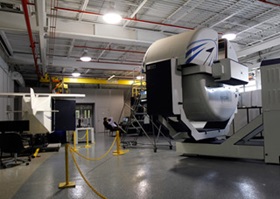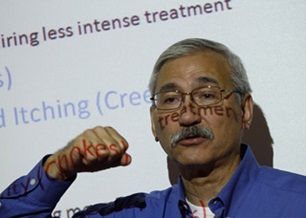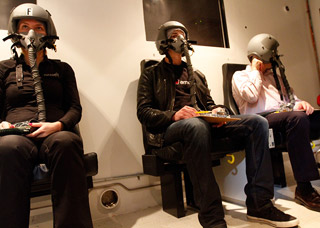The nondescript exterior of the industrial complex just outside of Philadelphia offers no clues about the extremes to which they push pilots inside—all in the name of training and safety, of course.

The National AeroSpace Training and Research Center, a subsidiary of Environmental Tectonics Corp., is both a simulation center like no other, and a showroom for the various devices made by ETC to spin, swoop, and suck the oxygen out of paying customers. It draws a mix of military and civilian pilots, scientific researchers, and, more recently, those aspiring to be launched into space by commercial operators.
Inside the spartan confines of a steel box fitted with pipes and pumps, a long hiss and series of clangs and groans reverberate while a technician’s disembodied voice reports increasing altitudes through headphones inside a fighter pilot-style helmet. Under two sets of watchful eyes, a staffer and four pilots prepare to remove oxygen masks once the pressure drops to the equivalent of 25,000 feet.
There was, perhaps, a touch of anxiety for at least one of those pilots during the ascent, as pipes banged and clanged, a heavy steel door closed tight, and unknown challenges lay ahead. Classroom training has covered all of the physiology in detail, along with what to expect, but like many things, being told is one thing and experiencing is quite another.
At 25,000 feet, masks come off and the fun begins. A series of simple tasks rapidly grow increasingly challenging, and it is easy to see that flying an airplane can become impossible in seconds, or a couple of minutes, if cabin pressure fails at the flight levels.
“We train for extreme environments,” said Director of Space Training and Research Brienna L. Henwood, who has joined the class for a refresher session of her own.
Beyond the steel confines of the altitude chamber await simulators, all made by ETC, that offer a unique opportunity for general aviation pilots: flight simulation that includes the sustained application of G forces, up to and potentially beyond the limits of human endurance, customized to realistically portray business jets, airlines, military jets, or spaceships.

The Phoenix Centrifuge, which can be fitted with an array of interchangeable cockpits, was idle on this particular day, being prepared for the next round of training. Henwood gave a tour of the machine, patting its metal skin with a devilish grin, announcing, with obvious pride, that it is capable of delivering a 10-G acceleration in one second, the first three quarters of a turn around the room. According to the spec sheet, it can subject an occupant to up to 12 Gs, using rotation against inertia to simulate the full force of highly accelerated flight. (Gulp.) It is equipped with cockpit controls, displays, and medical monitoring equipment.
“We train for high-performance flight, loss of control in flight, all of those emergencies,” Henwood said. “We need to have that rapid onset … have the pilots fly those vehicles like they would in real life.”
(Worth noting here that the typical space mission profile incorporates much more modest accelerations, in the range of 4 Gs, based on a profile posted on the wall outside of the control room.) Henwood said that the cockpit, which rotates and tilts at the end of the centrifuge’s long arm, can fool the vestibular sense into thinking the acceleration is happening in any other direction, and respond appropriately to control inputs from the pilot inside.
Henwood said the training does not leap from zero to full speed: “We’ll gradually build you up through a series of programs.”
Down the hall, a less daunting simulator dubbed Gyrolab spins in smaller circles, though it also induces and sustains G loads on the pilots training inside. Steve Charbonneau, a corporate pilot and member of the NBAA Safety Committee, and chairman of NBAA’s Business Pilot Training Project, emerges from his upset recovery simulation looking calm, cool, and collected. He had just practiced a series of nose-high upset recoveries, an instructor and technician monitoring an array of cameras and controls outside, Charbonneau working within the completely enclosed cockpit.
Charbonneau reflected on the value of training like this.
“What was unusual was the application of G forces while in a simulator, which is, I think, unique to this program,” Charbonneau said. While he has logged plenty of time in Level D simulators (systems that typically put the cockpit in motion atop an array of six hydraulic legs), he said those simulators lack what the Gyrolab can deliver, and sustain: “You don’t get that G experience which, I think, is really critical to performing that maneuver properly. You really have to experience the G.”
‘Maybe a little more subtle than I expected’
As a training tool, induced hypoxia has important benefits.
It’s a reminder that even general aviation pilots flying at piston altitudes should take care, and the effects of hypoxia, particularly on vision, can begin at 5,000 feet. Illness, dehydration, and fatigue can exacerbate hypoxia, and trouble can begin far lower than many pilots might think.

Director of Physiology Training Glenn B. King stood at the front of a classroom, running a slideshow with a mix of still and animated images detailing the physiology of high altitude flight. He has himself just been to the flight levels, testing military equipment inside the chamber with air thinned to match the pressure found at 40,000 feet or more. (The chamber, Henwood explained on the tour, can produce a pressure environment of more than 100,000 feet. Again, no thanks.) Even at Flight Level 400, breathing becomes a challenge, not an afterthought, as the body struggles to expel air from the lungs with virtually no ambient pressure to help in the task. For King, doubling over and huffing out gulps of thin air is another day at the office. Two of his pupils, airline captain Gabriel Engle and the AOPA writer, have never experienced the effects of altitude-induced hypoxia. Today’s agenda begins with 30 minutes of breathing pure oxygen to help reduce the chance of decompression sickness during or after a sustained “visit” to 25,000 feet, where oxygen masks will be removed and the chamber occupants, under the watchful eye of Director of Educational Programs Gregory Kennedy, who keeps his mask on and acts as chaperone. Trainees attempt a series of simple tasks, including a quiz printed on a sheet of paper that tests basic arithmetic skills, the ability to read and understand basic questions, and a maze of the sort found in children’s coloring books or family restaurant placemats. This was to prove quite challenging after just a minute or two off of oxygen.
King explains that each person will experience a few of several possible symptoms, such as light headedness, air hunger, tingling sensations in the extremities, or euphoria. The complex of symptoms that signal the onset of hypoxia is unique to each individual. While they may not always appear in the same order, the same set of symptoms will be characteristic of every hypoxic experience the trainee encounters for the rest of his or her life. Learning the unique response of one’s body to thin air can help a pilot recognize the most insidious form of decompression at altitude, the slow and silent leak that, though thankfully rare, has brought down airlines and corporate jets, flight crews unconscious before they could act.
With the mask off, the writer quickly loses interest in the quiz sheet, captivated by what others are doing with a child’s toy sphere with shaped holes for shaped blocks, the sort of thing that can keep a kindergartner happy for a while. Triangle in the triangle slot—yay! The first one was easy. The writer’s gaze tracked this red and blue ball of fun around the room, as Kennedy passed it from pilot to pilot. Everything felt just fine, and, really, who the heck cares what 325 divided by 25 equals, anyway?
King, watching intently from just outside a window, reminded the occupants not to wait until they pass out—the onset of symptoms is enough. Time to put the mask on, and set the oxygen to full flow.
Clarity returns in just a few seconds, with the lesson learned. In moments, technicians manning a control console outside will “descend” the chamber to 18,000 feet and Kennedy passes a color wheel to illustrate the significant degradation of color vision experienced in low light and low oxygen.
A rapid decompression from 41,000 feet, where useful consciousness without oxygen is measured in seconds, fills the chamber with water vapor and rounds out the experience. Engle, who has been flying airlines for a decade, had never experienced hypoxia before, and found it surprisingly unsurprising. It was essentially as he imagined it would be, “maybe a little more subtle than I expected,” Engle said. “You have to experience it firsthand.”
‘I don’t think it hurts to have a pipe dream’
Engle, the airline captain, has come to NASTAR Center on his own dime, with a dream. As Virgin Galactic, Space Exploration Technologies (SpaceX), Boeing, and other companies prepare to ramp up commercial astronaut programs that will send citizens into space, Engle hopes to one day be in the cockpit.

The altitude chamber training alone can be had for $500, and upset prevention and recovery training costs $2,500. A basic space flight participant course (designed for scientists and tourists who will fly to space, but not actually command the vehicle) is priced at $3,000. NASTAR Center offers spaceflight crew training as well, though the price is not set because training is customized for each particular program and vehicle, Henwood said. It includes a mix of experiences, including simulated launch and reentry, and emergency operations.
Engle said being an astronaut is a dream that began in childhood.
“When people ask me that, I always wonder why somebody wouldn’t want to do that,” Engle said of departing the atmosphere altogether. While there is not yet a clear path to follow from an airline cockpit to a spaceship, Engle plans to be prepared, with unique experiences added to his résumé. “I don’t think it hurts to have a pipe dream, and to prepare just in case that dream becomes a possibility at some point.”
Established in 2007 (the parent company, ETC, has operated for more than 40 years), NASTAR Center has a significant head start on others expected to offer commercial spaceflight training for passengers and crew, having staked a claim as the only nongovernment facility in the world able to offer G force in the context of flight simulation. Clients and partners include U.S. and foreign militaries, along with a host of academic and research institutions. The spaceflight simulation systems are the first approved by the FAA for commercial space training, and the centrifuge, with interchangeable cockpits, can replicate exactly the sensations of launch and reentry.
“You literally feel like you’re launching straight up into the sky,” Henwood said.
The company is also helping to test new systems for the commercial space industry. When the David Clark Co. developed its new pressure suit for the coming generation of commercial astronauts, staff came here to test it. Richard Branson, planning to take the first post-test flight into space aboard his Virgin Galactic spaceship, came here to train.
The timetable for commercial space operations remains uncertain, though Branson recently announced Virgin Galactic is poised to begin powered test flights of its Scaled Composites-designed spaceship, and Branson hopes to launch paying customers within two years.
Meanwhile, NASTAR Center continues to offer more traditional advanced aviation training, and can push any pilot to their limits—and beyond.



